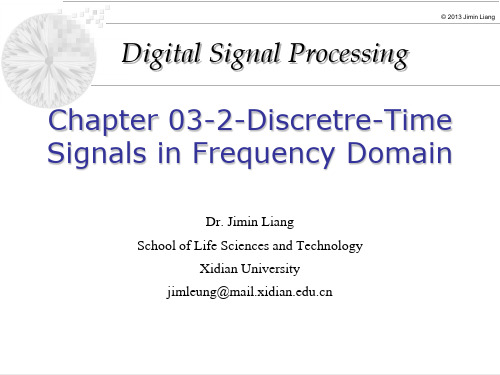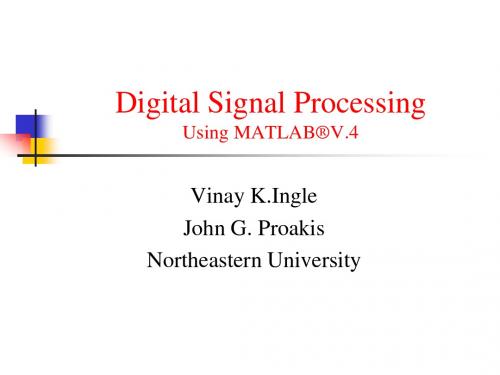Chapter 2-Discrete-Time Signals in the Time Domain140228(无动画)
- 格式:ppt
- 大小:786.50 KB
- 文档页数:53




信号与系统专业英语句子Signals and Systems: A Comprehensive Overview.In the realm of engineering and science, signals and systems play a pivotal role in understanding and processing information. A signal represents a physical quantity that varies over time or space, such as an audio waveform, an image, or a time series. A system, on the other hand, is a mathematical model that transforms or processes a signal to produce an output signal. Together, signals and systems form the foundational concepts for a wide range of applications in fields such as signal processing, communications, control systems, and computer science.Signal Characteristics.Signals can be categorized based on various characteristics, including:Continuous-Time Signals: These signals are definedover a continuous time interval, meaning they can take on any value within that interval. Examples include analog audio signals and continuous waveforms.Discrete-Time Signals: These signals are defined only at specific time instances, making them suitable fordigital processing. Examples include sampled audio signals and digital images.Analog Signals: These signals represent continuous values and are typically associated with continuous-time signals. They can take on any value within a given range.Digital Signals: These signals represent discrete values and are typically associated with discrete-time signals. They can only take on specific, quantized values.System Properties.Systems are characterized by their properties, which determine how they process signals. These properties include:Linearity: A system is linear if the output signal is proportional to the input signal. In other words, the system does not introduce any distortion or nonlinearities.Time-Invariance: A system is time-invariant if the output signal is the same regardless of when the input signal is applied. In other words, the system's behavior does not change over time.Stability: A system is stable if its output signal remains bounded for all bounded input signals. In other words, the system does not amplify or oscillate uncontrollably.Signal Processing.Signal processing involves manipulating and transforming signals to extract useful information or achieve specific objectives. Common signal processing techniques include:Filtering: Removing or isolating specific frequency components from a signal.Smoothing: Averaging out variations in a signal to reduce noise or distortion.Compression: Reducing the size of a signal while preserving its essential information.Demodulation: Recovering the original signal from a modulated carrier signal.Applications of Signals and Systems.Signals and systems have innumerable applications across various domains:Communications: Designing and implementing communication systems for transmitting and receiving information, such as wireless networks and optical fiber systems.Control Systems: Designing and analyzing systems that automatically control physical processes, such asindustrial machinery and robotics.Signal Processing: Developing algorithms and techniques for processing signals to improve their quality, extract information, or extract features.Image Processing: Analyzing and manipulating digital images for object recognition, medical imaging, and computer graphics.Speech Processing: Analyzing, synthesizing, and recognizing human speech for applications such as voice recognition and speech synthesis.Mathematical Tools.The mathematical tools used in the analysis and synthesis of signals and systems include:Fourier Transform: Decomposes a signal into itsfrequency components.Laplace Transform: Represents a signal in the complex frequency domain.Z-Transform: Represents a discrete-time signal in the complex frequency domain.Linear Algebra: Models systems as matrices and uses matrix operations to analyze their behavior.Differential Equations: Describes the dynamics of continuous-time systems.Conclusion.Signals and systems are essential concepts that underpin a wide range of technological advancements and scientific discoveries. By understanding the characteristics and properties of signals and systems, engineers and scientists can design and implement sophisticated systems for processing and analyzinginformation, enabling breakthroughs in communication, control, signal processing, and many other fields.。


Digital Signal Processing – A Computer-Based Approach, 4th Edition: Teaching Design IntroductionDigital Signal Processing (DSP) is the use of mathematicalalgorithms to manipulate signals in various ways. DSP has numerous applications in many fields such as telecommunications, audio processing, and biomedical engineering. The fourth edition of Digital Signal Processing – A Computer-Based Approach provides a comprehensive introduction to the field of DSP.In this teaching design, we will discuss how to use this textbook to teach DSP to undergraduate students. We will also provide an outline of the content that will be covered during the course.Course OverviewThe course will be divided into three sections. The first sectionwill introduce the fundamental concepts of DSP. This section includes chapters one to four of the textbook. The second section will cover advanced topics in DSP such as filter design and spectral analysis. This section includes chapters five to nine of the textbook. Finally, thethird section will introduce students to various applications of DSP. This section includes chapters ten and eleven of the textbook.Teaching StrategyThe teaching strategy for this course will be a combination of lectures, tutorials, and laboratory sessions. Lectures will be used tointroduce key concepts, while tutorials will be used to provide examples of how to apply these concepts. Laboratory sessions will allow students to gn practical experience in implementing DSP algorithms using software tools such as MATLAB.Course OutlineSection One: Fundamental Concepts of DSPChapter One: Introduction to Digital Signal Processing•Analog versus Digital Signals•Digital Signal Processing ApplicationsChapter Two: Discrete-Time Signals and Systems•Discrete-Time Signals•Discrete-Time Systems•Analysis of Discrete-Time Linear Time-Invariant (LTI) SystemsChapter Three: Frequency-Domn Analysis of Signals and Systems •Discrete-Time Fourier Transform (DTFT)•Fourier Series for Periodic Signals•Finite-Length Discrete Fourier Transform (DFT) Chapter Four: z-Transform•Definition and Properties of z-Transform•Inverse z-Transform•Analysis of Discrete-Time LTI Systems in the z-DomnSection Two: Advanced Topics in DSPChapter Five: FIR Filter Design•Design of Linear-Phase FIR Filters•Windowing Methods for FIR Filter Design Chapter Six: IIR Filter Design•Design of IIR Filters•Butterworth and Chebyshev Filters Chapter Seven: Multirate Signal Processing •Downsampling and Upsampling•Polyphase Decomposition•Filter BanksChapter Eight: Power Spectrum Estimation•Periodogram Method•Welch Method•Blackman-Tukey MethodChapter Nine: Adaptive Filtering•Least Mean Square Algorithm•Recursive Least Squares Algorithm•Applications of Adaptive Filtering Section Three: Applications of DSPChapter Ten: Audio Processing•Audio Sampling and Quantization•Audio Compression•Audio EqualizationChapter Eleven: Image Processing•Image Sampling and Quantization•Image Enhancement•Image CompressionConclusionIn conclusion, Digital Signal Processing – A Computer-Based Approach, 4th Edition is a comprehensive textbook that covers the fundamental concepts of DSP, advanced topics in DSP, and various applications of DSP. This teaching design provides instructors with an outline of how to use this textbook to teach DSP to undergraduate students. Through lectures, tutorials, and laboratory sessions, students will gn a thorough understanding of DSP and its various applications.。